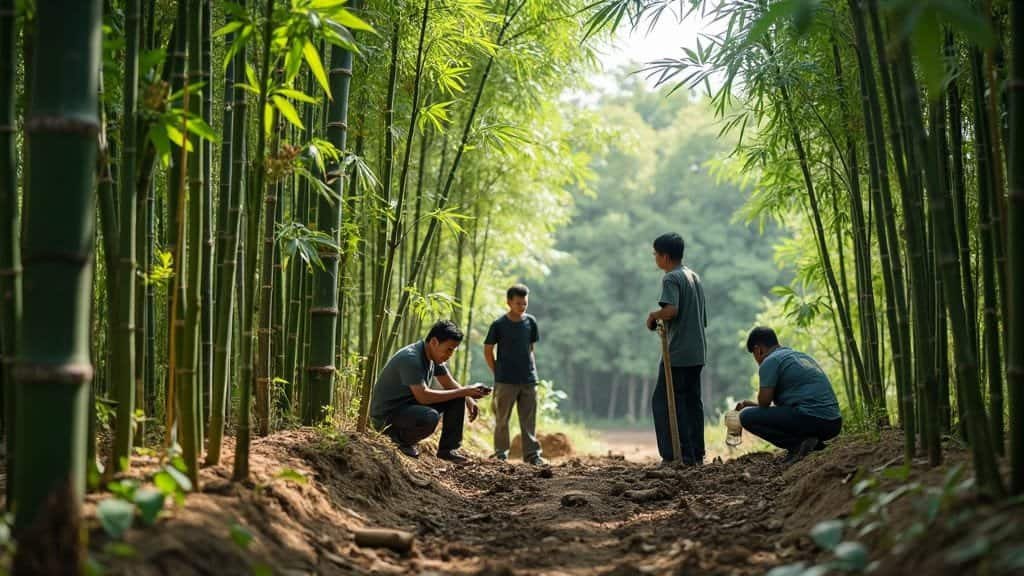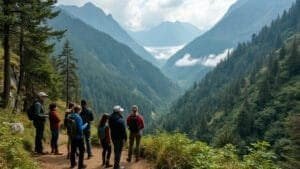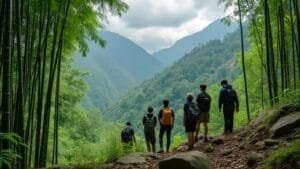The Red Panda Network plays a central role in safeguarding the future of red pandas through a unique blend of grassroots conservation, scientific research, and community empowerment. Operating primarily in Nepal, where over half of the world’s wild red pandas live, the organization has pioneered a community-based model that protects habitat while improving the lives of local people. From establishing the world’s first red panda protected forest to training hundreds of Forest Guardians, the Red Panda Network is building a conservation movement that spans forest patrols, education initiatives, and global partnerships
In this article, we explore how the Red Panda Network contributes to red panda conservation by restoring critical habitats, engaging communities in forest stewardship, and creating measurable impacts for this endangered species
Red Panda Network’s Forest Protection and Monitoring Programs

At the heart of the Red Panda Network’s mission is a deep commitment to preserving and restoring the natural forest habitat that red pandas depend on. This work begins in the rugged, biodiverse eastern Himalayas—specifically in Nepal—where more than 50% of the global wild red panda population resides
To protect these critical environments, the organization has implemented a combination of forest protection zones, reforestation initiatives, and grassroots wildlife monitoring that is now being adopted as a model for conservation success across the region
Establishment of Red Panda Conservation Areas
One of the Red Panda Network’s most groundbreaking achievements has been the establishment of the Panchthar–Ilam–Taplejung (PIT) Red Panda Protected Forest. This area, which spans over one million acres, is the world’s first protected forest corridor created specifically for red pandas. Located within the Kangchenjunga Singhalila Complex—an international conservation priority—the PIT corridor connects isolated habitat patches and enables red pandas to safely move across territories that had become fragmented due to agriculture and logging
Beyond large-scale forest corridors, RPN has also worked directly with local municipalities and community forest groups to designate smaller but equally vital conservation zones. One key example is the Puwamajhuwa Community Red Panda Conservation Area, a grassroots initiative in eastern Nepal that protects 116 hectares of temperate broadleaf forest, home to native bamboo and the red pandas that rely on it for both food and shelter
These protected areas are managed through a collaborative approach that includes village leaders, forest user groups, and local conservation committees. This community ownership ensures that protection isn’t just top-down but is integrated into local decision-making processes—an approach that significantly improves both effectiveness and compliance
Role and Impact of the Forest Guardians Program
The Forest Guardians Program, launched in 2010, is one of the most powerful tools the Red Panda Network uses to implement forest protection on the ground. Forest Guardians are local men and women who are trained and paid to patrol red panda habitat, document wildlife activity, remove snares set by poachers, and monitor forest health. They also collect ecological data that feeds directly into RPN’s scientific database, helping researchers track red panda population trends and habitat conditions
From a modest start with 16 individuals, the Forest Guardian network has expanded dramatically. As of 2024, there are over 128 trained guardians operating across 95 community forests in 12 districts of Nepal. These guardians cover thousands of acres of forest each month, often trekking through remote and difficult terrain to ensure that red panda habitats remain safe and undisturbed
More than just a workforce, Forest Guardians act as ambassadors of conservation within their communities. They raise awareness about the importance of red pandas and sustainable forest use, shifting public attitudes away from resource exploitation and toward stewardship. Many of them have also become informal educators, speaking at local schools and public events about the importance of protecting biodiversity
Scientific Monitoring and Red Panda Research Projects
The Red Panda Network doesn’t stop at protecting forests—it also leads efforts to understand red panda ecology through cutting-edge research. They launched the first-ever community-based red panda monitoring program, which has become a cornerstone of national wildlife tracking in Nepal. Their researchers have conducted the country’s first national red panda survey, mapping out population densities, habitat use, and human pressures across multiple provinces
One of RPN’s landmark research collaborations was with Rotterdam Zoo, which supported the world’s first GPS collaring study of red pandas in the wild. This project yielded unprecedented data on red panda movement, home range, and daily activity patterns. Such insights are critical for designing effective conservation corridors, predicting how red pandas respond to climate change, and identifying key zones for reforestation
Additionally, Forest Guardians contribute valuable field data that supports academic research and policy recommendations. Their observations have revealed patterns in red panda seasonal movements, feeding behavior, and threats such as illegal grazing or firewood collection in protected zones
To learn more about RPN’s habitat connectivity work and reforestation efforts, explore their update on the PIT conservation corridor, which highlights how protected forests are being restored to ensure a future for red pandas in the wild
Community Engagement and Educational Outreach

The Red Panda Network recognizes that conservation success is only possible when the people who live closest to wildlife are fully involved in protecting it. For this reason, RPN’s strategy goes far beyond habitat monitoring—it integrates local culture, education, and sustainable development to create a shared vision of coexistence between people and red pandas
Their programs aim to inspire long-term environmental stewardship by equipping communities with the knowledge, skills, and motivation needed to care for the forests they depend on
Red Panda Conservation Through Local Involvement
RPN’s community-based approach is centered on giving local people a leading role in red panda conservation. Through partnerships with village committees, forest user groups, and district-level conservation councils, the organization helps communities take ownership of forest protection. These partnerships include joint planning of conservation areas, training workshops in sustainable land use, and support for local governance around forest resource management
In addition to Forest Guardians, many community members are engaged in habitat restoration activities such as nursery development, bamboo planting, and erosion control. These efforts help to rebuild the degraded forest undergrowth that red pandas rely on for food and nesting. By including women and marginalized groups in these efforts, RPN also promotes equity and resilience within forest communities
One standout example of this is the empowerment of women in red panda range areas through educational scholarships and training in conservation and leadership. This has led to greater female representation in forest committees and an expanded role for women in decision-making about resource use and protection. By focusing on inclusive engagement, RPN ensures that its conservation work is not only ecologically sustainable but also socially transformative
Education Initiatives in Nepal and Worldwide
Education is a core pillar of the Red Panda Network’s mission, and it extends from local schools in Nepal to global awareness campaigns. Within red panda range communities, RPN runs educational outreach programs that include environmental classes for schoolchildren, community film screenings, and informational workshops on biodiversity conservation
These efforts have reached nearly half the population living in red panda range areas in Nepal. In schools, RPN has supported the formation of “Roots and Shoots” youth groups, which empower students to take action on conservation issues. They’ve also developed educational materials aligned with the national curriculum to help teachers integrate wildlife conservation into their regular lessons
Beyond Nepal, RPN engages an international audience through initiatives like International Red Panda Day, which raises global awareness about red panda threats and conservation needs. The event is celebrated each September and supported by zoos, conservation centers, and individuals worldwide. It includes fundraising, red panda-themed activities, and educational events that spotlight the species’ ecological importance and cultural significance
RPN also collaborates with global partners to distribute conservation toolkits to zoos and schools around the world. These resources include lesson plans, red panda facts, and conservation games designed to make learning about biodiversity engaging and impactful for all ages
This blend of grassroots outreach and global education has helped build a conservation movement that transcends borders. Through storytelling, scientific sharing, and immersive education, the Red Panda Network cultivates a new generation of conservation advocates both in the Himalayan highlands and around the globe
To see how their education and outreach connect communities with conservation action, visit RPN’s mission and outreach overview, which outlines the organization’s holistic approach to saving red pandas
Global Collaboration and Long-Term Conservation Impact

The Red Panda Network’s work extends far beyond the borders of Nepal, thanks to a growing network of international partners, donors, and supporters. Through strategic collaborations and long-term conservation programs, RPN is transforming how red panda protection is practiced—not just as a local priority, but as a global environmental imperative
Their work links habitat protection with climate resilience, community empowerment, and the preservation of biodiversity at scale
Sustainable Livelihood Projects Supporting Forest Health
In many red panda range areas, forest degradation is driven by economic necessity. Families rely on firewood, grazing, and small-scale agriculture to survive, which can put them in direct conflict with conservation goals. To address this, the Red Panda Network has developed several sustainable livelihood initiatives that provide alternative income sources while reducing pressure on forests
One major program involves the distribution of improved cookstoves, which reduce firewood consumption by up to 50%. These stoves not only preserve forest biomass but also improve indoor air quality and reduce health risks for families, especially women and children. By combining environmental and health benefits, this initiative has become a cornerstone of RPN’s sustainable development model
In addition to clean energy solutions, RPN promotes eco-tourism and handicraft production as income-generating alternatives. In communities near red panda habitats, trained guides lead red panda tracking treks for visitors, generating revenue that supports local conservation. Handicrafts made by local artisans—often inspired by red pandas and forest life—are sold through conservation partner channels, helping families earn a living without cutting down trees
These efforts have benefited over 2,000 families across Nepal and continue to grow with donor support and international fundraising. RPN also trains community members in nursery management, helping produce native bamboo and tree seedlings for reforestation projects. This closed-loop system ensures that economic empowerment and ecological restoration go hand-in-hand
International Partnerships and Red Panda Network’s Measurable Results
Red Panda Network’s effectiveness is magnified by its strong international collaborations. From strategic funding partners like Zoo Boise and Nature Planet to scientific institutions like Rotterdam Zoo, RPN works closely with organizations that bring expertise, visibility, and financial support to the table. These partnerships allow for resource-sharing and ensure that best practices in conservation are applied at all stages of program development and execution
Through these global efforts, RPN has achieved measurable conservation milestones. Over one million acres of red panda habitat are now under improved protection through community forests and corridor restoration. Their “Plant A Red Panda Home” initiative has resulted in the planting of more than 813,854 trees, including native bamboo, with a goal of 850,000 by the end of 2024. These reforestation projects are not only helping red pandas but also improving water regulation, carbon storage, and climate resilience in Himalayan landscapes
RPN’s monitoring data suggest that red panda sightings are increasing in key conservation zones, signaling a potential rebound in population where their model has been most deeply implemented. These ecological gains are complemented by significant social impacts, such as greater gender equity in conservation work, broader youth engagement in forest stewardship, and increased local ownership of biodiversity protection
Supporters from around the world can contribute to this success through symbolic red panda adoptions, monthly giving programs, and volunteering opportunities. These channels connect global audiences with fieldwork on the ground, creating a truly international conservation community
To explore how partnerships and donors support red panda protection, visit the LEX Reception feature on RPN, which highlights how corporate sponsorships and global supporters amplify local impact











